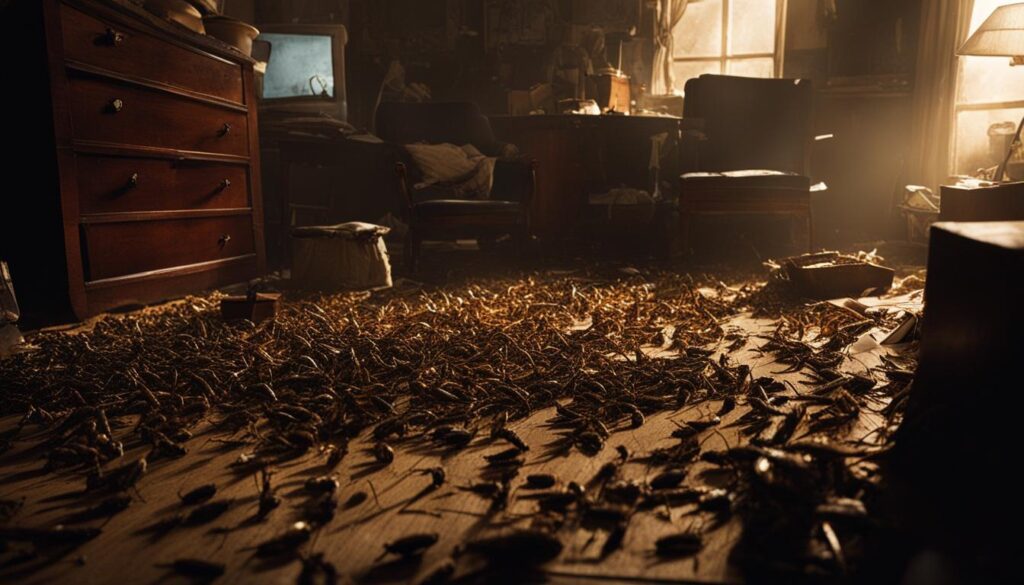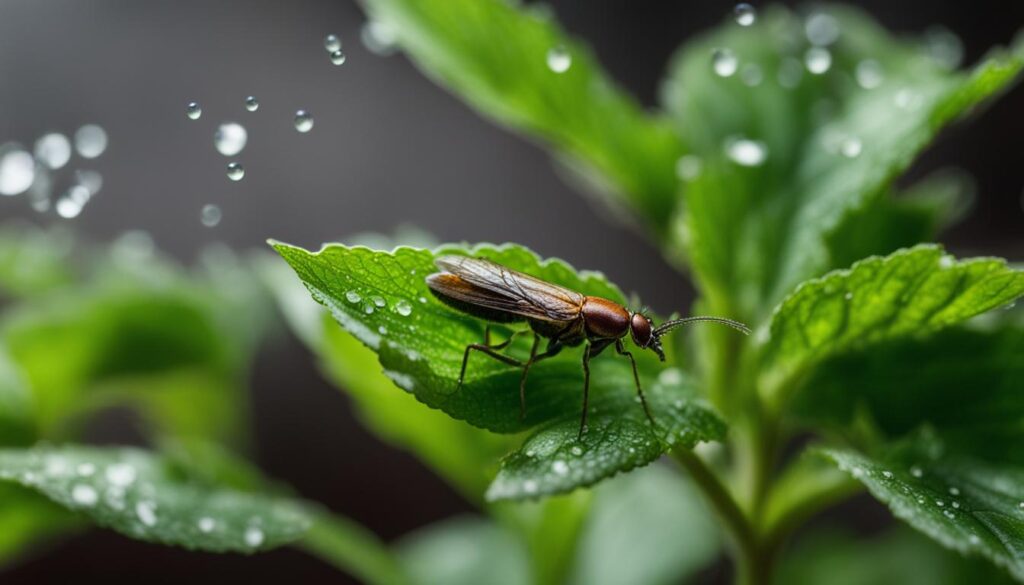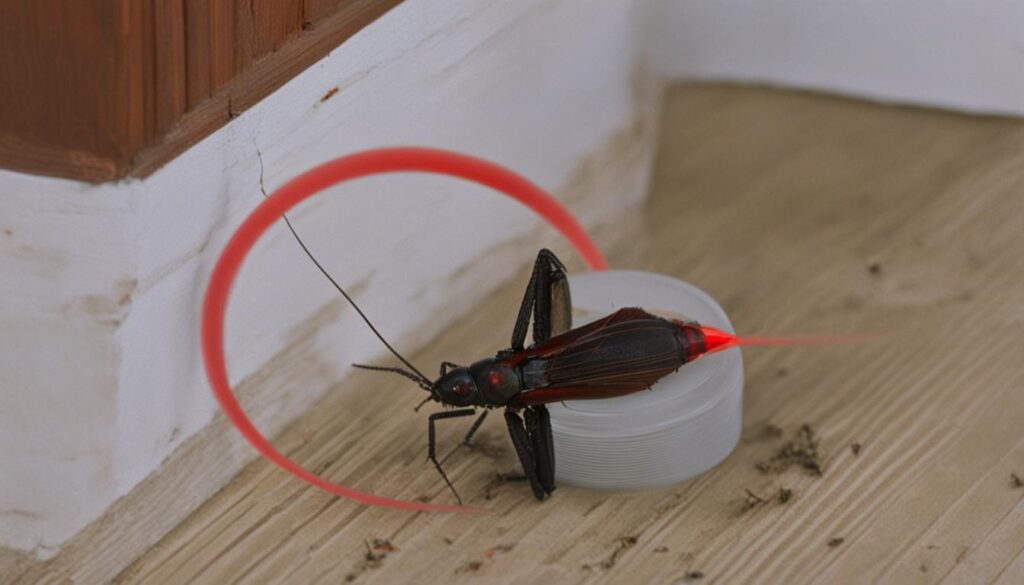As someone who loves a peaceful home, I’m keenly aware of the disturbance that crickets can cause. These pests aren’t just an auditory nuisance with their incessant chirping; they can also be quite destructive, particularly to houseplants. In my quest for a serene living space, I’ve delved deeply into various cricket control methods, focusing on eliminating crickets from the house. It turns out that the secret lies not only in dealing with the visible culprits but also in creating an environment that’s less appealing to these insects.
Moisture is a cricket’s best friend, and my experience has taught me that my home needs to stay dry and uninviting to them. Sealing entry points is crucial, but so is keeping my place clean and free of any food sources that might attract these critters. Discovering the balance of natural repellents and sticky traps has proven effective in my cricket-infestation solutions, and I’m excited to share these strategies with you.
Key Takeaways
- Effectively eliminating crickets often requires addressing their love for moisture-heavy environments.
- Cricket infestations can be mitigated by thorough home sealing and cleanliness to remove attraction sources.
- Natural repellents, such as diatomaceous earth and essential oils, play a significant role in repelling these pests.
- Sticky traps offer a non-toxic and straightforward approach to cricket control.
- Consistent application of preventive measures is key to maintaining a cricket-free home.
Understanding Cricket Attractions and Habitats
Ever noticed that familiar chirping in your home and wondered why these little critters have chosen your space for their symphony? Let’s delve into the world of crickets that hustle and bustle in our homes, their cozy corners, and what draws them to our living areas.
Types of Crickets Commonly Found in Homes
The uninvited concert in our homes typically stars house crickets, field crickets, and camel crickets as the main performers. Each of these species is unique: while house crickets carry a yellowish-brown hue and distinctive dark bands atop their heads, field crickets offer a stark contrast with their larger, often black appearance. And then we have the humpbacked camel crickets. Silence is their forte, as they don’t partake in the nocturnal chorus we associate with their cousins.
These different cricket types are not just passersby—they can create a full-fledged infestation if given the right welcoming conditions. So, my fellow homeowners, it’s high time for cricket prevention!


Why Crickets Prefer Indoor Environments
The innate desire of crickets for a warm, cushy, and moist home brings them scurrying into our spaces, particularly when the weather leans toward the balmy side. It turns out, these miniature musicians share our love for comforts such as a cozy basement or a humid kitchen. It’s their love for omnivorous dining—ranging from plant matter to fabrics—that we need to be vigilant about.
Picture this: it’s a humid summer night, and your home feels like a sanctuary from the heat. Much to my dismay, it’s also a haven for crickets. Thus, I’ve learned that preventing cricket infestations is about forming a strategy. It involves using dehumidifiers to drop that moisture level down, ventilating all rooms thoroughly, and cleaning like there’s no tomorrow. Why? Because every little crumb or neglected nook can be a cricket’s dream pad.
So if you’re ready to reclaim your home from these squatters, join me in implementing these steps as our cricket infestation treatment plan. Together, let’s transform our homes back into the cricket-free sanctuaries they deserve to be.
Addressing the Moisture Problem to Deter Crickets


As I venture through the process of making my home less appealing to crickets, I’ve learned that moisture reduction is a pivotal aspect to focus on. High humidity levels provide the perfect breeding ground for these insects, which is why I turned to using dehumidifiers especially in places like basements and areas prone to dampness.
Fixing leaks and ensuring efficient drainage has been a game-changer in maintaining a dry environment that crickets are less attracted to. Moreover, I noticed that my efforts indoors had a positive side effect outdoors, and they’re helping in eliminating crickets from the garden, too.
- Regularly check for water leaks and fix them promptly.
- Clean gutters and downspouts to ensure proper water flow away from your home.
- Utilize dehumidifiers in humid areas like basements, kitchens, and bathrooms.
- Ensure good airflow through proper ventilation in your house.
By taking these steps, I’ve seen a notable decrease in cricket intrusions, and my garden has become less of a cricket hotspot. It’s more work at first, but the peace and quiet afterward make it entirely worth it. Remember, reducing moisture not only helps in making your indoor spaces cricket-proof but also goes a long way in eliminating crickets from your garden and creating a more enjoyable outdoor space.
Maintaining a Clean and Food-Free Environment


When it comes to a cricket-free home, I can’t stress enough the importance of keeping our living spaces immaculate. Crickets, being the scavengers they are, feast on the crumbs and remnants of our meals. To effectively kill crickets and ensure they don’t see our homes as a buffet, I’m meticulous about removing any food particles that could attract these chirpy invaders. Here are some key steps I’ve taken to get rid of crickets in the house:
- Regularly vacuum floors to remove any food crumbs – an immediate deterrent for a cricket looking for its next meal.
- Sweeping under kitchen appliances and furniture to make sure no food is left behind, unnoticed by us but a target for crickets.
- Securely sealing food in containers and promptly cleaning dirty dishes, leaving no temptation for crickets to stick around.
- Disposing of garbage regularly and using bins with tight-fitting lids to avoid inadvertent cricket feasts.
By incorporating these practices into my routine, I’ve made substantial progress in getting rid of crickets inside the house. Just a few minutes each day invested in these tasks can make a difference, turning my home into an inhospitable environment for crickets and ensuring peace without the ceaseless evening serenade of these pests.
How to Get Rid of Crickets with Natural Repellents
I’m always looking for ways to protect my home from pests in a safe and natural manner, which is why I’m keen on sharing my experiences with natural cricket repellents. When it comes to cricket extermination, I’ve found that certain non-toxic methods are not only effective but also much safer for use around the house.


One of the most touted solutions is diatomaceous earth. This natural cricket repellent is made up of fossilized remains of tiny aquatic organisms, and its fine powder can create an impassable barrier for these critters. I simply sprinkle it in corners, basements, and areas where cricket activity is observed.
The Effectiveness of Natural Repellents Like Diatomaceous Earth and Essential Oils
Another approach I champion is the use of essential oils repellent. Oils such as neem, peppermint, and citronella not only smell great to us but are also quite effective in making our homes undesirable to crickets. Just a few drops in a diffuser or mixed with water in a spray bottle, and you’ve got yourself a natural deterrent against these jumping pests.
Setting Up Sticky Traps: A Non-Toxic Solution
For those of us who prefer DIY cricket extermination techniques, sticky traps come in handy. They can be positioned strategically where crickets are prone to roam, such as entryways and along the walls. The real beauty of sticky traps lies not just in their non-toxic cricket control capability but also in their adaptability; these inconspicuous strips can be placed virtually anywhere without causing a fuss.
- Diatomaceous earth: Sprinkle in target areas to dehydrate crickets upon contact
- Essential oils: Diffuse or spray a mixture of repellent oils like neem, peppermint, and citronella
- Sticky traps: Place near areas of cricket activity for an effective and non-toxic way to capture crickets
So, when considering what get rid of crickets, don’t overlook these natural and effective options. They may be just what you need for peace of mind and a cricket-free home.
Effective Cricket Control for a Peaceful Home
The journey to how to get rid of crickets in house is paved with simple yet powerful techniques. As I’ve learned and adopted various cricket pest management strategies, my home has transformed into a serene sanctuary, free from the incessant chirping that once kept me up at night.
Embarking on this quest, I discovered that how to get rid of crickets inside house effectively hinges on a few key practices. The cornerstone of which is creating an inhospitable environment for these unwanted visitors. By employing strategies such as reducing indoor moisture, ensuring a meticulous cleaning regime, and rigorously sealing potential entry points, the likelihood of a cricket’s prolonged stay diminishes greatly.
- Maintain low moisture levels by fixing leaks and using dehumidifiers.
- Keep your living space immaculately clean, leaving no food for crickets to feast on.
- Seal off any cracks or crevices to prevent crickets from entering your home.
Moreover, natural repellents are my go-to solution for when the question arises: how do you get crickets out of your house? Simple aids like diatomaceous earth and essential oil blends work wonders in deterring these insects. And if some do manage to sneak in, sticky traps serve as an excellent defense line, halting them in their tracks without the use of harmful chemicals.
Remember, the secret to a cricket-free environment is persistence and consistency in applying these strategies. Soon enough, you’ll enjoy the tranquility of your home without facing the disruptions caused by these ubiquitous chirpers.


DIY vs. Professional Cricket Control: Choosing the Right Approach
As the warmer months approach and the symphony of crickets begins, I often find myself evaluating the effective ways to eradicate crickets lingering around my living spaces. For many of us, the choice between rolling up our sleeves for some DIY cricket removal and calling in the professionals can be quite the conundrum. Now, if you’re dealing with the occasional chirper that’s strayed into your personal quarters, a DIY approach should suffice. This might include essential measures such as sealing up cracks, maintaining a rigorously clean environment, utilizing natural repellents, or deploying sticky traps in strategic locations around your residence.
On the other hand, when the scenario scales up from a single mischievous cricket to an entire choir, it’s a clear signal that a more intensive cricket control strategy is required. Especially when it comes to removing crickets from the garden, professional exterminators bring a level of expertise and a toolbox of advanced methods that go beyond what I can typically do on my own. These experts not only target the existing infestation with precision but also implement preventive strategies to ensure that crickets don’t make a comeback.
Ultimately, I have to be honest with myself about the severity of the infestation and how comfortable I feel tackling the pesky critters. While I can often manage small issues independently, in recognition of my limits, I am not hesitant to enlist professional help when necessary. Sometimes it’s about understanding that the peace of mind that comes from knowing my home and garden are cricket-free is invaluable. Whether choosing DIY methods or professional services, it’s the results that matter—effective ways to remove crickets and restore tranquility to my living spaces.
FAQ
What are the most effective methods for cricket control?
The most effective cricket control methods include maintaining a clean environment to eliminate food sources, using natural repellents like diatomaceous earth and essential oils, setting up sticky traps, and addressing moisture issues with dehumidifiers to make your home less appealing to crickets.
Can you identify the types of crickets commonly found in homes?
Yes, the types of crickets most commonly found in homes are house crickets, characterized by yellowish-brown coloration and dark bands on their heads; field crickets, which are often black and larger in size; and camel crickets, notable for their humpback appearance.
Why do crickets prefer indoor environments?
Crickets are drawn to indoor environments that provide warm, moist, and quiet conditions which are ideal for their survival and reproduction. Homes offer abundant food sources and suitable nesting conditions, particularly during warmer and humid seasons.
How important is moisture reduction in eliminating crickets from the garden and house?
Moisture reduction is critical in deterring crickets from both gardens and homes. Ensuring proper drainage, fixing leaks, and using dehumidifiers can make these areas less inviting to crickets, thus helping to prevent infestations.
What are some natural repellents for getting rid of crickets?
Natural repellents include diatomaceous earth, which dehydrates crickets upon contact, and essential oils such as neem, peppermint, citronella, and citrus, which emit strong scents that are unappealing to crickets.
Are sticky traps effective for cricket extermination?
Yes, sticky traps are an effective and non-toxic solution for managing cricket populations. They can be strategically placed where crickets are likely to travel, like near doors and windows, capturing them effectively without the use of harmful chemicals.
How can I maintain a clean and food-free environment to discourage cricket infestations?
To maintain a clean and food-free environment, you should regularly vacuum and sweep to remove food crumbs and debris, keep your kitchen surfaces clean, store food properly, and remove any potential cricket food sources like plants or organic waste.
Should I try DIY cricket removal or call in the professionals?
It depends on the severity of the infestation and your level of comfort with pest management. For minor infestations or as a preventative measure, DIY methods such as using natural repellents and maintaining a clean environment can be effective. However, for larger infestations or persistent problems, especially outdoors, professional cricket control may be necessary to completely eradicate the problem.

